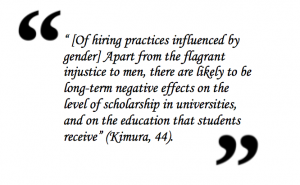Fulfilling Quotas: How Gender and Race Discrimination Still Exist in Academia and in the Workplace
Gender discrimination.
When we hear these words, most of us are immediately filled with negative emotions. Perhaps we imagine a man being selected over an equally qualified woman for a critical job position, or even a woman being harassed as she walks down the street. These are certainly examples of what gender discrimination can be. But what about a woman receiving a prestigious physics fellowship, a fellowship offered only to females? Does this also qualify as discrimination?
Equality vs. Fairness
I am a white female currently living in the United States and choosing to pursue a career in a STEM field. I have been told that, as a woman entering an area of the workplace well known for being male-dominated, I have an advantage. I can’t complain, of course, but I have to wonder: why should I have an advantage? What is it about me being a female that gives me preference over equally qualified males? The only difference between my equally qualified male peers and me is that I am a member of an underrepresented group. Girls of color are told they are at even more of an advantage – to get into top schools, to get hired for jobs in STEM – than their Caucasian and/or male peers.
It seems that in the modern university setting and workplace, there is a constant effort made to reach equality. Equal numbers of men and women, all races represented and accounted for. But is this really what we should be striving for? It is true that having a diverse environment in which to learn or work can promote creative thinking and enhance self-awareness. However, this mindset leads to the development of quotas – for gender, race, socioeconomic status, etc. – that must be considered when choosing which student to accept at a university or which candidate to hire at a company. In the pursuit of fulfilling these quotas, certain minority groups are at an advantage, and consequently, majority groups at a disadvantage.
This is especially true of the math and science fields. There is a distinct lack of women in these fields, and many scholarships and fellowships for women have been created to increase the numbers. Universities, in an effort to maintain equality and diversity, compete to attract the fewer number of competitive and interested women to their campus.
Problems with Using Quotas
Gender and race quotas allow for a diverse and enriching academic or work environment. Yet, how many qualified students or job candidates are overlooked in the search for minorities? If the opposite were to occur – say, a software company preferentially hired males or Caucasians – there would be outrage and cries of discrimination. Hiring or accepting persons preferentially on the basis of gender or race, even if those persons are members of a minority group, fits under the umbrella definition of discrimination. These practices can also be detrimental in the long run to the university or company. If that university or company in question accepts or hires a less qualified candidate for the sake of his or her gender or race, the quality of work received will likely reflect that.
There are advantages and disadvantages to using to quota system. Whether gender or race should play into the decision to hire or accept someone at all is controversial and highly debated. If we want to find the most productive, yet still diverse, environment possible, we are likely going to have to strive for a balance.
Works Cited:
Kimura, D., Ceci, S.J. (2007). “‘Underrepresentation’ or misrepresentation?”. Why Aren’t More Women in Science? Washington, DC: American Psychological Association.
A Journey of Self-Discovery: Why We Should Become Aware of Our Own Gender Biases (Camilli, Blog 1)
When it comes to careers in math and science, women seemed to have pulled the short straw. In general, women are paid less than men for doing the same job, move through the ranks more slowly, and are less likely to reach top positions. There are also far fewer women than men that actually choose careers in STEM (Science, Technology, Engineering, and Math) (Valian, 27-28). But why is this?
Virginia Valian, distinguished professor of psychology and linguistics at Hunter College and the Graduate Center of the City University of New York, proposes that “a combination of gender schemas and the accumulation of advantage” may be at least partially responsible (Valian, 28). So, what does that mean?
Bias in the Workforce
When I sat down to read about Valien’s ideas on gender schemas, there was one study in particular that made me stop and think. The study, published in 2004, aimed to test people’s views of women’s competence in the workforce. Those participating in the study were required to read background information about male and female “assistant vice presidents” in an aircraft company. When asked to rate each person’s competence and likability, the male “assistant vice president” was judged to be more competent than the female. Both were estimated to be equally likeable. However, when the background information included a stellar performance review for both the male and female “assistant vice presidents”, the results changed. The male and female were judged to be equally competent, but the female was now assumed to be considerably less likeable (Valian, 33-34).
This study serves to emphasize the gender bias that can be found in our workplace. Before being given the performance review, both male and female evaluators automatically assumed that the woman was less competent than her male counterpart.
As Valian states in her work, the evaluators were not intending to be biased. There was no conscious discrimination against women; evaluators likely weren’t even aware that gender was a factor in how they were judging the candidates. Yet, women are suffering the consequences of this unconscious bias.
How can we change something that is unconscious?
So, we realize that gender bias is a problem in the workplace, particularly in STEM fields. Females are passed over for jobs, or opportunities within their own disciplines, because their gender raises doubts about their competence. But if this gender discrimination is ingrained and unconscious, how can we possibly change it?
Like most social changes, the process of eliminating gender discrimination will likely be long, and may never disappear completely. But with the rise of females taking credits in STEM in high school, at rates surpassing those of their male peers (U.S. Department of Education, 2007), there is hope that more females will push past gender stereotypes and choose to pursue careers in STEM.
It if my belief that the more women succeed in math and science careers, the more gender bias in the workplace will decrease. The women that hurdle the obstacles of gender bias, and become successful in STEM fields, have the potential to show others that women can be competent in stereotypically male careers. They can also serve as strong female role models for the next generation. If children grow up seeing males and females as equal in the workplace, they will not develop the unconscious biases present in most adults today. Those adults that maintain an outdated way of thinking will slowly leave the workforce, and the times where males are unjustly favored over females will be less common. Eventually, the gap between males and females has the potential to disappear.
Looking Inside Ourselves
As of today, women are still unequally represented in math and science fields. The gender biases present make it difficult for women to advance their careers, or even obtain equal pay. For this reason, it may be a long time before that gender gap closes completely.
However, our generation can start by examining the gender biases we ourselves may possess. How do we view women in professional careers? Catching ourselves making unconscious judgments could be the first step in changing the way we think, in making the unconscious a little more conscious. If we all make an effort to be more aware of our prejudices, we get a little closer to a world without gender bias.
Works Cited:
Valian, V., Ceci, S. J. (2007). “Women at the top in science – and elsewhere”. Why Aren’t More Women in Science? Washington, DC: American Psychological Association.
(2007). “The nation’s report card: America’s high school graduates”. U.S. Department of Education, National Center for Education Statistics. Results from the 2005 NAEP High School Transcript Study, by C. Shettle et al. Washington, DC: Government Printing Office.
Welcome to UR Blogs
Welcome to your student blog for the FYS-Women in Science!



